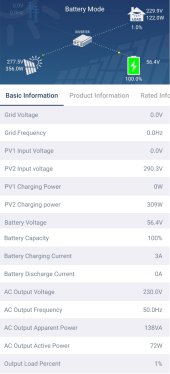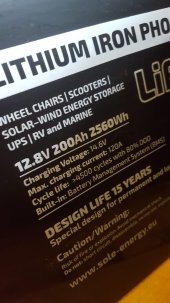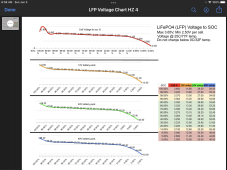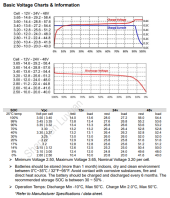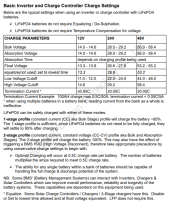Hello everyone,
I’m sorry for asking this question which is probably already answered, my lack of knowledge about this topic and too much information, lack of battery datasheet confuse me a lot so I have to ask it in the hope, that someone with more experience can give me advice (if required I can pay).
My OFF Grid 8kW solar system includes:
8x JINKO Solar panel 315W
1x Sole Uni Max MPPT 8000VA-48V
4x LIFePo4 12.8V-200Ahm lithium-ion battery, 2560WH
Battery balancer
Connected devices:
Fridge (all day), TV, boiler (which is turned ON only over day), mobile/laptops charger, couple of bulbs
What would be the best stability and long live parameters for my batteries?
Right now I use battery type = User with default parameters and I'm scared that I may brake something with it (read long story).
When this type is selected according to the manual I Can change the 26, 27, and 29 options.
05 - Battery type = User
Available - AGM, Flooded, User, Pylon, Weco, Soltaro, Lib, Lic
26 – Bulk charging voltage (C.V voltage) = 56.4V (default!)
Posible range – 48V to 62
27 – Floating charging voltage – 54V (default!)
Possible range – 48V to 62V
29 – Low DC cut-off voltage – 44V (default!)
Possible range: 42V to 48V
Should I maybe follow Will Prowse's suggestion in this thread?
48V 16S LiFePO4 Battery w/ BMS
Absorption: 58V (for long live 56.4V)
Float: 54.4V
Inverter Cut-off: 42.8V-48V
Long story if someone wants to know why do I ask this:
I ordered the OFF Grid 8kW system and it was installed by the dealer. I tough it will be “good to go” but it was not.
The dealer told me the battery came at 100%, and when he connected it, they were at 50% according to the inverter.
The first night after installation I spent 25% off the battery and the next morning I had fault 04 (low battery).
That sunny day battery did charge to ~50/55% and again overnight I spent 25% off the battery.
On the next sunny day battery did charge from 25% to 80%, but after using a 1600w vacuum cleaner for only 10 minutes (while solar panels were producing ~400W) battery went from 80% to 49%.
As the dealer doesn't answer calls I checked settings and accidentally (at night) changed "Battery type" to "user". After a couple of minutes in WatchPower App, the battery status showed from 50% to 80%, according to the app overnight I spend around 10-15% of the battery and the battery gets charged really fast to 100% over the day.
But I'm scared if this is fine for my system as I don't want to overkill anything and reduce the life of components.
I’m sorry for asking this question which is probably already answered, my lack of knowledge about this topic and too much information, lack of battery datasheet confuse me a lot so I have to ask it in the hope, that someone with more experience can give me advice (if required I can pay).
My OFF Grid 8kW solar system includes:
8x JINKO Solar panel 315W
1x Sole Uni Max MPPT 8000VA-48V
4x LIFePo4 12.8V-200Ahm lithium-ion battery, 2560WH
Battery balancer
Connected devices:
Fridge (all day), TV, boiler (which is turned ON only over day), mobile/laptops charger, couple of bulbs
What would be the best stability and long live parameters for my batteries?
Right now I use battery type = User with default parameters and I'm scared that I may brake something with it (read long story).
When this type is selected according to the manual I Can change the 26, 27, and 29 options.
05 - Battery type = User
Available - AGM, Flooded, User, Pylon, Weco, Soltaro, Lib, Lic
26 – Bulk charging voltage (C.V voltage) = 56.4V (default!)
Posible range – 48V to 62
27 – Floating charging voltage – 54V (default!)
Possible range – 48V to 62V
29 – Low DC cut-off voltage – 44V (default!)
Possible range: 42V to 48V
Should I maybe follow Will Prowse's suggestion in this thread?
48V 16S LiFePO4 Battery w/ BMS
Absorption: 58V (for long live 56.4V)
Float: 54.4V
Inverter Cut-off: 42.8V-48V
Long story if someone wants to know why do I ask this:
I ordered the OFF Grid 8kW system and it was installed by the dealer. I tough it will be “good to go” but it was not.
The dealer told me the battery came at 100%, and when he connected it, they were at 50% according to the inverter.
The first night after installation I spent 25% off the battery and the next morning I had fault 04 (low battery).
That sunny day battery did charge to ~50/55% and again overnight I spent 25% off the battery.
On the next sunny day battery did charge from 25% to 80%, but after using a 1600w vacuum cleaner for only 10 minutes (while solar panels were producing ~400W) battery went from 80% to 49%.
As the dealer doesn't answer calls I checked settings and accidentally (at night) changed "Battery type" to "user". After a couple of minutes in WatchPower App, the battery status showed from 50% to 80%, according to the app overnight I spend around 10-15% of the battery and the battery gets charged really fast to 100% over the day.
But I'm scared if this is fine for my system as I don't want to overkill anything and reduce the life of components.
Attachments
Last edited:



